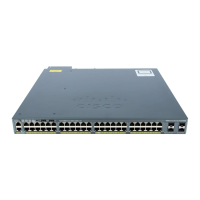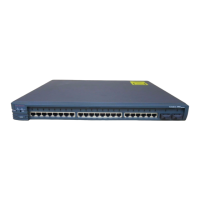When you make PoE configuration changes, the port being configured drops power. Depending on the new
configuration, the state of the other PoE ports, and the state of the power budget, the port might not be powered
up again. For example, port 1 is in the auto and on state, and you configure it for static mode. The switch
removes power from port 1, detects the powered device, and repowers the port. If port 1 is in the auto and on
state and you configure it with a maximum wattage of 10 W, the switch removes power from the port and
then redetects the powered device. The switch repowers the port only if the powered device is a class 1, class
2, or a Cisco-only powered device.
Power Monitoring and Power Policing
When policing of the real-time power consumption is enabled, the switch takes action when a powered device
consumes more power than the maximum amount allocated, also referred to as the cutoff-power value.
When PoE is enabled, the switch senses the real-time power consumption of the powered device. The switch
monitors the real-time power consumption of the connected powered device; this is called power monitoring
or power sensing. The switch also polices the power usage with the power policing feature.
Power monitoring is backward-compatible with Cisco intelligent power management and CDP-based power
consumption. It works with these features to ensure that the PoE port can supply power to the powered device.
The switch senses the real-time power consumption of the connected device as follows:
1
The switch monitors the real-time power consumption on individual ports.
2
The switch records the power consumption, including peak power usage. The switch reports the information
through the CISCO-POWER-ETHERNET-EXT-MIB.
3
If power policing is enabled, the switch polices power usage by comparing the real-time power consumption
to the maximum power allocated to the device. The maximum power consumption is also referred to as
the cutoff power on a PoE port.
If the device uses more than the maximum power allocation on the port, the switch can either turn off
power to the port, or the switch can generate a syslog message and update the LEDs (the port LED is now
blinking amber) while still providing power to the device based on the switch configuration. By default,
power-usage policing is disabled on all PoE ports.
If error recovery from the PoE error-disabled state is enabled, the switch automatically takes the PoE port
out of the error-disabled state after the specified amount of time.
If error recovery is disabled, you can manually re-enable the PoE port by using the shutdown and no
shutdown interface configuration commands.
4
If policing is disabled, no action occurs when the powered device consumes more than the maximum
power allocation on the PoE port, which could adversely affect the switch.
Maximum Power Allocation (Cutoff Power) on a PoE Port
When power policing is enabled, the switch determines one of the these values as the cutoff power on the
PoE port in this order:
1
Manually when you set the user-defined power level that the switch budgets for the port by using the
power inline consumption default wattage global or interface configuration command
2
Manually when you set the user-defined power level that limits the power allowed on the port by using
the power inline auto max max-wattage or the power inline static max max-wattage interface
configuration command
Catalyst 2960-XR Switch Interface and Hardware Component Configuration Guide, Cisco IOS Release 15.0(2)EX1
OL-29420-01 87
Configuring PoE
Power over Ethernet Ports

